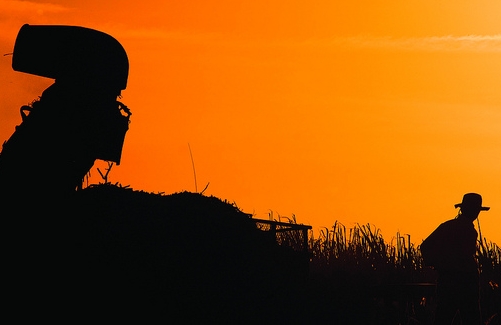Podcast: Play in new window | Download
Subscribe: RSS

Sugar cane, Brazil is discovering, is not the hoped-for panacea for energy independence. Photo credit: Sweeter Alternative
For years, all the countries that hoped wistfully for energy independence, or renewable energy, or the oxymoronic “sustainable industry,” have looked to Brazil as a shining country on a hill that did it all, and had it all. It was inspiring. A typical headline of a few years ago (simply Google “Brazil” to see dozens) appeared in The Daily Texan: “Brazil’s Energy Program Could Teach U.S.” It turns out to have been a perfect example of the mendacity of hope (see my essay About Hope).
Nearly 70 per cent of the electricity in Brazil (which uses plenty, in its huge mining and metallurgical industries, for example) is hydro power. It’s clean! It’s renewable! It’s almost gone!
Severe drought across Brazil has reduced the flows of rivers and the levels of reservoirs so much that severe blackouts were widespread at the end of last year, and emergency rationing of electricity is widely feared this year. When you worship industrial growth, rationing electricity is the equivalent of putting shackles on a sprinter.
Well, at least the country still has its energy independence thanks to biofuels from sugar cane. Unlike the crass Americans, who rely on corn for their ethanol and thus divert a source of food for the hungry into the tanks of their Hummers, savvy Brazilians went with sugar cane, which is twice as productive per acre as corn, hence cleaner and greener to grow, and produces fuel that is half as expensive as gas. It gave Brazil its energy independence.
Snag 1. The aforementioned drought. It has wiped out a third of this year’s cane crop.
Snag 2. To get in on the boom, industrial farmers have spread cane fields not only across Brazil’s agricultural land, pushing other crops (and cattle) out, but into both the Atlantic and Amazon rain forests. This. along with heavy applications of synthetic fertilizer and widespread burning involved in the cane harvest, is contributing to climate change, which brings us back to Snag 1.
Here is the law: If it’s industrial, it’s not sustainable. If a farm, or a community of farms, used part of its acreage to grow cane (or for that matter, corn) for transportation fuel, while maintaining the overall diversity of plants and the health of the soil, that would work. A similar diversity in distributed electric production, where for example you used hydro but also had solar in place, would allow a farm or a small community to endure a drought.
But the minute you scale it up for profit, increase the distribution, maximize the economies of scale, you concentrate and magnify the risks to yourself and future generations. Somebody walks away with the cash profits tomorrow, the rest of us suffer the long term consequences next decade.
This is the lesson Brazil has for the United States. Don’t hope for this.
I for one am not surprised. Years ago when I lived and worked in Colombia I witnessed first hand the continual encroachment on the jungles and rainforests of the Amazon basin. What happened in the quest for progress was shortsighted and temporary gains at the expense of the future. Having said that, though, I must add that in another lifetime I worked at the Johns Hopkins Applied Physics Laboratory. And, during the oil embargo in the early 1970s–when we were all sitting in gas lines–I was tasked by my boss to write a white paper looking at alternative energy. In doing so, I interviewed a lot of smart guys at the lab in looking at every thing from solar, tidal, and geothermal to wind and nuclear power and more. All held much promise. But, as one physicist pointed out to me, the problem for all these forms of energy was scalability. That is, the issue of large scale production and distribution. Another bright physicist said large scale production wasn’t a problem, but rather a pipe dream. He advocated totally changing our concept of how to generate power. Specifically, his solution was to shift to local generation and local consumption. He talked, for example, about how those who lived in single family homes could generate their own power with solar panels. Or perhaps those living in rural areas could do the same thing in conjunction with wind power. Alas, here we are 40 years later and we are still groping for a solution, let alone smart policy and cohesive and workable strategies. In my humble opinion, this shows just how lacking in leadership and vision our government and corporate masters are. What the future holds is anyone’s guess. One thing, though, that is certain, absent action, the problem is self correcting. That is, we will ultimately run out of large scale energy resources and all of us will have to adapt to the new realities.
Well said, and thanks for the perspective. I argued in Brace for Impact and I arguie still that distributed power is the thing that can save any of us who embrace it. If we make our power and grow our food where we are, in a sustainable way, we will be all right. If it’s industrial, it’s going to fail.